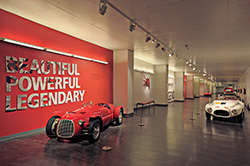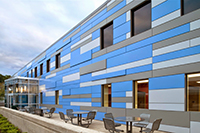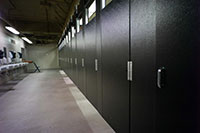view all Case Studies
Lighting Systems Spotlight Prized Vehicles in Museum

To prepare for its 2012 opening, the LeMay Museum's lighting needs received particular consideration, as exposure to natural sunlight can severely damage automotive finishes and interiors.
December 8, 2014 -
Lighting
The LeMay Museum in Tacoma, Wash., is home to more than 350 historically significant cars and motorcycles. The collection is comprised of vehicles from late Tacoma business leader Harold LeMay, who amassed the largest privately owned collection of automobiles in the world. The museum covers 165,000 square feet and four stories.
To prepare for its 2012 opening, the facility’s lighting needs received particular consideration, as exposure to natural sunlight can severely damage automotive finishes and interiors. To show off the unique features of the vehicles, the museum wanted a lighting design that would highlight and complement the collection. To meet these specifications, the museum brought Juno Lighting Group on board. The museum selected the Trac-Master track system and Cylindra LED fixtures for implementation.
The high-color accuracy of the LEDs gives a true representation of the automotive paint work, bringing out the detail in finishes that are difficult to highlight, such as metallics, pearlescents, and metal flakes. The LEDs also offer a high level of color consistency from one display to another, creating an aesthetic experience for visitors. The LED fixtures also light walls, backdrops and automotive art objects. More than 740 LED fixtures are in use at the museum.
More than 70 of the museum’s cars are illuminated using six or seven Trac-Master luminaires per vehicle. Fixture specifications were customized depending on the application, including both 22- and 45-watt track heads with outputs ranging from 1,000-2,500 lumens. Spot, narrow-flood, and floodlight distributions with various filters were also chosen to allow light to be directed as needed, and general illumination to accent design features, such as hood ornaments, hubcaps, and taillights.
The fixtures feature a 50,000-hour rated service life, saving maintenance costs on re-lamping and associated labor compared to either halogen or CMH light sources.
Over the life of the LEDs, the museum projects to recoup 60 percent of its investment in the fixtures and installation costs through energy and maintenance savings. The local utility provider estimates the museum reduced its overall energy consumption by 70 percent annually by selecting LED fixtures.
“The lighting solution from Juno Lighting Group is not only improving efficiency, providing energy savings and properly illuminating the vehicles in the museum, it’s also benefitting the maintenance staff,” says Jeff Gordner, the museum’s facilities manager. “With the exceptionally long service life of the new fixtures, we can focus more on other projects as well as invest in improving the museum with the savings achieved from the energy efficient luminaires.”
Next
Read next on FacilitiesNet












